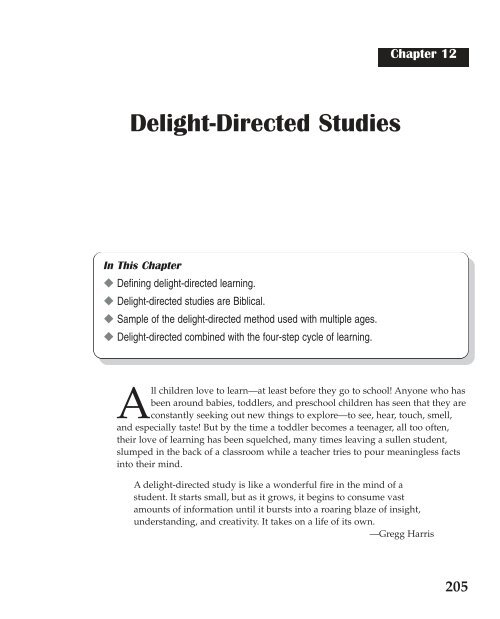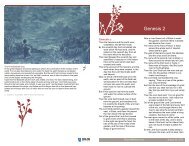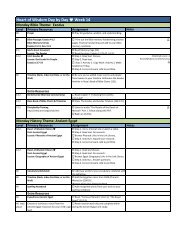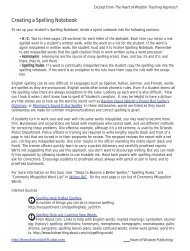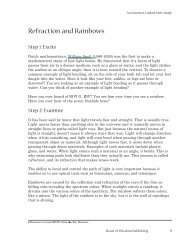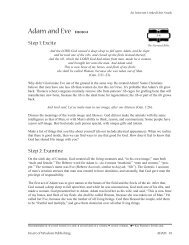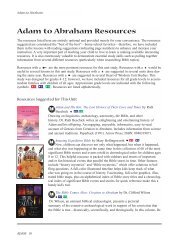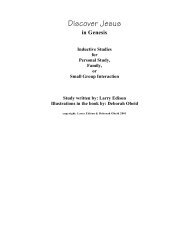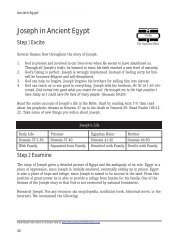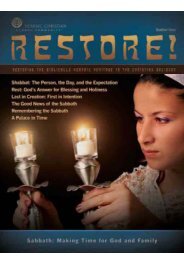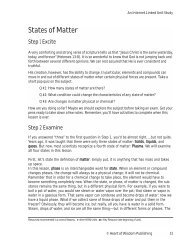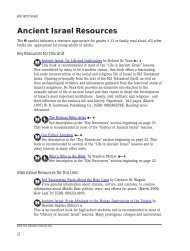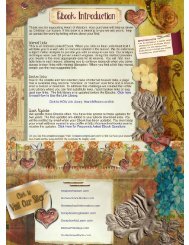Delight-Directed Studies - Heart of Wisdom
Delight-Directed Studies - Heart of Wisdom
Delight-Directed Studies - Heart of Wisdom
- No tags were found...
Create successful ePaper yourself
Turn your PDF publications into a flip-book with our unique Google optimized e-Paper software.
Chapter 12<strong>Delight</strong>-<strong>Directed</strong> <strong>Studies</strong>In This Chapter Defining delight-directed learning. <strong>Delight</strong>-directed studies are Biblical. Sample <strong>of</strong> the delight-directed method used with multiple ages. <strong>Delight</strong>-directed combined with the four-step cycle <strong>of</strong> learning.All children love to learn—at least before they go to school! Anyone who hasbeen around babies, toddlers, and preschool children has seen that they areconstantly seeking out new things to explore—to see, hear, touch, smell,and especially taste! But by the time a toddler becomes a teenager, all too <strong>of</strong>ten,their love <strong>of</strong> learning has been squelched, many times leaving a sullen student,slumped in the back <strong>of</strong> a classroom while a teacher tries to pour meaningless factsinto their mind.A delight-directed study is like a wonderful fire in the mind <strong>of</strong> astudent. It starts small, but as it grows, it begins to consume vastamounts <strong>of</strong> information until it bursts into a roaring blaze <strong>of</strong> insight,understanding, and creativity. It takes on a life <strong>of</strong> its own.—Gregg Harris205
Chapter 12 ➤ <strong>Delight</strong>-<strong>Directed</strong> <strong>Studies</strong>imperative for a parent to get to know theirchildren—to begin to see them with new eyes <strong>of</strong>understanding.It is imperative for a parent to get toknow their children—to begin to seethem with new eyes <strong>of</strong> understanding.Learn what makes your child tick. What is thatactivity or interest that they tend to gravitatetoward time after time? What motivates them tolearn? What is truly the inner delight <strong>of</strong> their life? What gifts and talents has God givento them that are unique to them alone? Who has God created them to be?God has a unique plan for your child’s life—and He has breathed into them the gifts andtalents that they will need to accomplish His purpose. The challenge is in discoveringthem—unearthing them from beneath the piles <strong>of</strong> textbooks and curricula that threatento squelch them out <strong>of</strong> existence—and then developing them for the glory <strong>of</strong> God.For we are God’s workmanship, created in Christ Jesus to do good works, which Godprepared in advance for us to do.—Ephesians 2:10God has prepared unique works for your child to perform. Your job is to prepare thechild to complete those tasks, and the best way to do that is through delight-directedstudies. The spark that God has placed within your child will be the thing that evokestheir own enthusiasm for certain topics and ideas—and you can then begin to preparethem for their life ahead by fostering that enthusiasm and causing it to grow.How Can You Use This Method With a Structured Plan?Is it possible to allow a child to study what hewants and still be sure you cover all the bases? Canyou instruct using the delight-directed methodwith a structured curriculum plan? Yes, and yes.The delight-directed method flows beautifully withthe four-step cycle <strong>of</strong> instruction in all <strong>Heart</strong> <strong>of</strong><strong>Wisdom</strong> unit studies.The spark that God has placed withinyour child will be the thing thatevokes their own enthusiasm forcertain topics and ideas.Each lesson can be skimmed, covering the basic concepts, while allowing the timeneeded to dwell on the things that delight the student. It’s like introducing new foods—the child won’t know if he likes or dislikes a food until he tries it. If it’s not his cup <strong>of</strong>tea, you can move quickly on to the next lesson, always looking for a spark <strong>of</strong> interest.Once you notice the spark, fan it until it grows into a flame.Consider what a great forest is set on fire by a small spark.—James 1:5.209
Section 3 ➤ The <strong>Heart</strong> <strong>of</strong> <strong>Wisdom</strong> Curriculum PlanPlanning and Looking for the Spark<strong>Delight</strong>-directed learning, with a set plan like <strong>Heart</strong> <strong>of</strong> <strong>Wisdom</strong> unit studies,begins by allowing children to be a part <strong>of</strong> the planning process. During theplanning phase, allow the student to participate in choosing the resources forthat unit (fiction novel, colorful reference book, video, Internet site, interactivemulti-media, etc.). It’s very possible that a child might balk at the unit as a wholebut later find a spark in one <strong>of</strong> the individual lessons. To continue with the foodanalogy, a child might, say, groan over something he sees cooking, but after ataste, finds it pleasing to his palate.ExampleMother is teaching Jenny (fifteen), John (thirteen), and Joseph (ten) a unit on the MiddleAges. During the unit planning the three decide together on the resources. They lookthrough the resources at Homeschool-Books.com or in the back <strong>of</strong> this book at theMiddle Ages Resources. The three choose Kingfisher Illustrated Encyclopedia, andEyewitness Medieval Life from their home library. Mother orders a novel, The Door in theWall (from the library or a vendor) to read aloud during the unit. While reviewing thelessons the children show the most interest in knights, castles, and medieval feasts.Before the unit begins they will pick up books on these topics from the library.Several opportunities will occur during the steps in each lesson to bring into play thedelight-directed methods. Let’s look at an example <strong>of</strong> how each <strong>of</strong> the three childrenmight discover their own level <strong>of</strong> interest in the lesson on knights.Unit: Middle Ages. Lesson: Knights1. In Step One (Excite) Mother is watching each student for a spark. Step One activitiesevoke feedback which shows how interested each child is in the topic and suggests thepossible duration <strong>of</strong> the lesson. As they brainstorm to make lists, John and Joshua bothshow an intense interest in this topic.2. In Step Two, Mother reads the provided text in the unit, and then turns to theresources chosen during the unit planning phase. She reads aloud from the suggestedpages in the Kingfisher Illustrated Encyclopedia and Eyewitness Medieval Life. John andJoseph spend time reading through the suggested web sites and library resources, andprint out several illustrations <strong>of</strong> a knight’s armor and weapons. Jenny also browses theInternet sites and chooses an image <strong>of</strong> a knight to add to her portfolio, but she leavesthe boys to explore the sites as she moves on to Step Three assignments.3. In Step Three, Mother allows each child to choose an activity:210
Chapter 12 ➤ <strong>Delight</strong>-<strong>Directed</strong> <strong>Studies</strong>• John (13) chooses to complete a writing assignment. Mother encourages thisassignment because he needs more writing practice and he enjoys this topic. Johnwrites a separate draft paragraph for each <strong>of</strong> several topics: tournaments, jousting,suits <strong>of</strong> armor, crossbows, and the Crusades. He searches or uses the Internet t<strong>of</strong>ind illustrations for each summary.• Joseph (10) chooses to create a shield with a coat <strong>of</strong> arms. He uses colored pencilsto design a coat <strong>of</strong> arms similar to those he viewed from the resources. He thenmakes the shield from cardboard and pastes or glues the coat <strong>of</strong> arms onto theshield.• Jenny is not as interested in this topic so she copies a paragraph from EyewitnessMedieval Life and moves on to a math lesson (more about Jenny later).4. In Step Four the students choose how they will share their work.• During this step, Mother and John are busy revising and correcting John’s drafts.After the corrections John glues illustrations to the summary pages and includesthem in his portfolio. He chooses to add more on this topic to his portfolio andshares it with his grandparents.• Joseph shows his shield to his father and explains his coat <strong>of</strong> arms.• Jenny adds her writing and illustrations to her portfolio and shares the work withher brothers.In this example all three children have learned about knights. John has obviously learnedthe most. We know all three have learned significantly more than they would in a typicalschool where the children would read perhaps one boring paragraph about knights.John and Joseph will continue on this topic in the coming weeks by choosing a noveland/or illustrated reference books from the library on knights, or by learning more fromthe Internet. Their wise mother will continue to fan the flame as long as the fire burns(weeks or months). If no spark had appeared during this lesson the amount <strong>of</strong> timespent on this lesson would have been dramatically different.Jenny did not do a lot with the lesson on knights because she did not have a spark <strong>of</strong>interest. Later, however, Jenny’s spark shows up in the “Food in the Middle Ages”lesson. She ends up spending several hours researching and planning an authenticmedieval feast for her family. She designs an elaborate menu for her portfolio and readsthe library book Medieval Feasts to Joshua.211
Section 3 ➤ The <strong>Heart</strong> <strong>of</strong> <strong>Wisdom</strong> Curriculum PlanFour-Steps Summary1. During Step One, look for the spark.2. In Step Two, the spark will be your signalto encourage your student(s) to go on tomore resources. If the lesson ignites aspark for one child and not another (whichWhile your children are given thefreedom to choose their courses <strong>of</strong>study, they are also given parameterswithin which they must work.will probably be the case) don’t force all the students into spending time on furtherstudy. Take a trip to the library, or order books, or allow computer time for Internetresearch.3. In Step Three, allow each child to choose the activity in which to do something withwhat he or she just learned.4. In Step Four, allow each child to choose how to share the material.Teaching is much more than providing facts—real teaching means causing to learn. Thedelight-directed methods work when we provide opportunities for meaningfulexperiences, and then wait and watch for moments when children’s eyes light up. Thenthey’re <strong>of</strong>f and running, determined and motivated to learn!<strong>Delight</strong>-<strong>Directed</strong> Does Not Equal Indulgence!An immediate misconception arises in many parents’ minds when they hear theterm delight-directed, and that misconception will remain unless and until theterm is defined properly. To allow your child’s education to be delight-directeddoes not mean that you as the parent/teacher will no longer have any say inwhat will be studied!In the <strong>Heart</strong> <strong>of</strong> <strong>Wisdom</strong> teaching approach the parent presents the material andlooks for the spark at the same time. It is essential to maintain a consistentroutine. We do not encourage allowing children to follow just any path <strong>of</strong>learning that delights them, with no rhyme, reason or pattern to guide them.While your children are given the freedom to choose their courses <strong>of</strong> study, theyare also given parameters within which they must work.Terry Camp explains the freedom in the delight-directed approach in her delightful bookIgnite the Fire:FIRE stands for Freedom Is Real Education. What do I mean by freedom? I do notmean allowing our children to have ultimate liberty. I do not mean that we allow ourchildren to play computer games ceaselessly. I do not mean our children are allowed212
Chapter 12 ➤ <strong>Delight</strong>-<strong>Directed</strong> <strong>Studies</strong>to watch movies, even “good” movies all daylong. The History Channel has some greateducational programs on it, but it will notteach our children to think and grow forthemselves. Instead, it will develop in them apassive learning process. An occasional showor two will not harm them, but if it becomesyour habit to “see if there’s something good<strong>Delight</strong>-directed does not meanindulging every whim and fancy <strong>of</strong>the child. Godly child trainingincludes a disciplined—not a haphazard—lifestyle.on,” then your children are missing out. I would rather they never watch anythingthan that they become educational vegetables.The freedom that I refer to is a freedom that comes only from following God. Nowthe Lord is the Spirit and where the Spirit <strong>of</strong> the Lord is, there is freedom.—II Corinthians 3:17Galatians chapter 5 is a great chapter on freedom. It begins, It is for freedom that Christhas set us free. Stand firm, then, and do not let yourselves be burdened again by a yoke <strong>of</strong>slavery (5:1). Verses 13 through 15 say, You, my brothers, were called to be free. But do notuse your freedom to indulge the sinful nature; rather, serve one another in love. The entirelaw is summed up in a single command. Love your neighbor as yourself. If you keep on bitingand devouring each other, watch out or you will be destroyed by each other.What does this mean for me in light <strong>of</strong> homeschooling? It means that I have had myyoke taken from me. Christ has set me free from my burdens. As a homeschoolingmom trying to follow a standard curriculum, I found myself bound. I found myselfburdened. It wasn’t until I gave up our homeschooling to Jesus, that I once againfound that freedom.I <strong>of</strong>ten found myself wanting to study a certain area with my children, but I feltconfined by the books I was using. I felt like I was giving them more work in what Ifelt was an already overloaded day. I was finding myself struggling with thepromptings <strong>of</strong> the Holy Spirit in my life. He would prompt me to study a certainarea with the children, and I would reason that there just wasn’t enough time.Now that I am turning to the Lord FIRST, I find the promptings from Him get done.It’s a great feeling knowing that your children are learning what the Holy Spiritwants them to learn. 4Children need boundaries, and they need guidance in the learning process. <strong>Delight</strong>directeddoes not mean indulging every whim and fancy <strong>of</strong> the child. Godly childtraining includes a disciplined—not a haphazard—lifestyle. <strong>Delight</strong>-directed studiesneed to take place in a routine—however flexible—that is orderly and makes sense.213
Section 3 ➤ The <strong>Heart</strong> <strong>of</strong> <strong>Wisdom</strong> Curriculum PlanIn addition, it is important to note that the delights that this chapter refers to are notnecessarily objects (such as dolls, Legos, or bicycles), but they are those ideas, activities,and interests that spark the child’s enthusiasm about learning something new.Individualized EducationIn Engines for Education, Roger Schank, from The Institute for the Learning Sciences,explains the importance <strong>of</strong> individualized education:Depending on an individual’s situation and goals, there are many things thatmight be worth learning. In order to give a very detailed prescription forwhat knowledge a student should acquire, we must take into account thatnot every child will need or want to do the same things. A curriculum musttherefore be individualized. It must be builtaround an understanding <strong>of</strong> what situationsa particular learner might want to be in, ormight have to be in later in life, and whatabilities he will require in those situations.Nevertheless, for many people, the notion<strong>of</strong> mandating the same knowledge forevery student is appealing. Building lists <strong>of</strong>facts that one claims everyone should knowWhen we ask how our children aredoing in school, we usually mean,“Are they measuring up to the prevailingstandards?” rather than, “Arethey having a good time and feelingexcited about learning?”is relatively simple to do. Furthermore, there is the attraction <strong>of</strong> providingstandards that can be easily measured. But from the perspective <strong>of</strong> theteacher and the student, this approach spells trouble. Each mandated bit <strong>of</strong>knowledge removes more local control and drives the system towards fixedcurricula and standardized tests, which not only diminishes teacherflexibility but also student choice, and therefore, student interest andinitiative.In public schools from first through twelfth grades, much <strong>of</strong> the classroomroutine is shaped by an emphasis on rote learning, a strict adherence tostandardized textbooks and workbooks, and a curriculum that is <strong>of</strong>tenenforced with drill and practice. The methods and the curriculum aremolded by the questions that appear on the standardized achievement testsadministered to every child from the fourth grade on. Success no longermeans being able to do. Success comes to mean “academic success,” a matter<strong>of</strong> learning to function within the system, <strong>of</strong> learning the “correct” answer,and <strong>of</strong> doing well at multiple-choice exams. Success also means, sadly,learning not to ask difficult questions. When we ask how our children aredoing in school, we usually mean, “Are they measuring up to the prevailing214
Chapter 12 ➤ <strong>Delight</strong>-<strong>Directed</strong> <strong>Studies</strong>standards?” rather than, “Are they having a good time and feeling excitedabout learning?”We should purpose to be flexible in the way we try to tap into our children’sinnate interests. When we are interacting with the student we can evaluatewhether learning has taken place. If one approach doesn’t work, we candrop it and try another. 5<strong>Delight</strong>-<strong>Directed</strong> Learning in Real LifeAll <strong>of</strong> this may sound wonderful to you, but you may be asking, “How can I make thiswork in real life?” We all want the education <strong>of</strong>our children to have meaning beyond justcircling the correct answer on an exam or fillingin the blanks correctly in a workbook. <strong>Delight</strong>directedlearning in real life means to look at theentirety <strong>of</strong> life as your child’s curriculum, to helpthem find what they are interested in, and thenallow them to dig in as deeply as they want.Learning this way is never dumbed down, andchildren can rise quickly to levels beyond a<strong>Delight</strong>-directed learning in real lifemeans to look at the entirety <strong>of</strong> lifeas your child’s curriculum, to helpthem find what they are interestedin, and then allow them to dig in asdeeply as they want to.traditional high-school education. Because the learning process belongs to them, theybegin to care about developing skills like writing and reading comprehension. They wantto improve and know more about the subjects that interest them, and they spend most <strong>of</strong>their waking hours actually learning.This type <strong>of</strong> learning is not inferior to atraditional education in any way—in fact, it issuperior, because a love <strong>of</strong> learning is beingfostered rather than rote facts being memorized.In real life, however, it can take more dedicationon the part <strong>of</strong> the parent/teacher to make itwork, because the education <strong>of</strong> every child in thefamily will be very different, based on their talents,interests, and speed <strong>of</strong> learning....it is superior, because a love <strong>of</strong>learning is being fostered ratherthan rote facts being memorized.Doesn’t delight-directed learning sound like fun? The good news is—it is, and it shouldbe fun! That’s what delight-directed study is all about: putting the delight back into theeducational process and fostering children who love to learn and who will makelearning a lifelong avocation.For more details see <strong>Heart</strong> <strong>of</strong> <strong>Wisdom</strong>.comSee another delight <strong>Directed</strong> example on the HOW Blog.215


